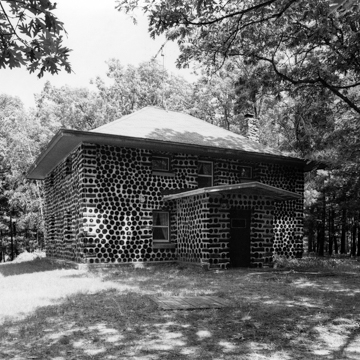Set amid the trees on the shore of Big Roche-A-Cri Lake, this lodge offers a rare glimpse of a vernacular building technique, stovewood construction. Wisconsin boasts a number of these buildings—perhaps more than anywhere else—but most of them have been sheathed with clapboard or plaster, concealing the stacked-wood effect. The absence of sheathing makes Cedar Lodge unusual, as does its late construction date. Morley built Cedar Lodge for himself and his wife Hazel around 1946. He probably chose the stovewood method because it was simple and inexpensive and because the eighteen-inch-thick walls provided excellent insulation in a cold climate. He tied the two-story, stovewood-stacked walls together by laying short logs at the corners in alternating directions, like quoins, and used the same technique for the edges of the windows and doors. Inside, the walls separating the rooms are also built of stovewood and mortar. A hipped, wide-overhanging roof covers the two-story building, and a one-story gabled vestibule shelters the entrance.
You are here
Cedar Lodge
If SAH Archipedia has been useful to you, please consider supporting it.
SAH Archipedia tells the story of the United States through its buildings, landscapes, and cities. This freely available resource empowers the public with authoritative knowledge that deepens their understanding and appreciation of the built environment. But the Society of Architectural Historians, which created SAH Archipedia with University of Virginia Press, needs your support to maintain the high-caliber research, writing, photography, cartography, editing, design, and programming that make SAH Archipedia a trusted online resource available to all who value the history of place, heritage tourism, and learning.


